Trees Birds Mammals Fish Amphibians Reptiles
Wild Algarve
Bookshop
Cortinarius triumphans Fr. - Birch Webcap
Phylum: Basidiomycota - Class: Agaricomycetes - Order: Agaricales - Family: Cortinariaceae
Distribution - Taxonomic History - Etymology - Toxicity - Identification - Reference Sources
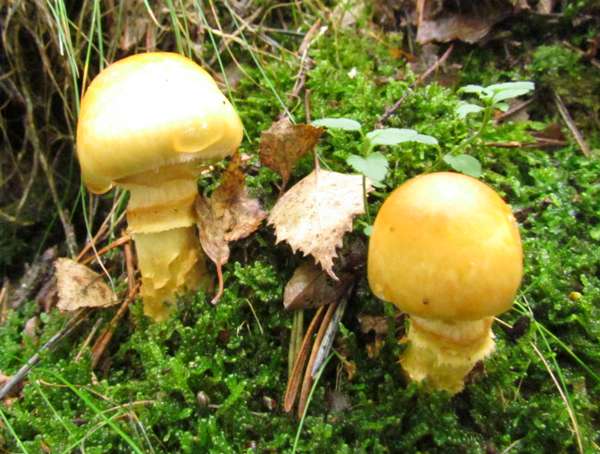
Cortinarius triumphans is an uncommon find throughout most of Britain and Ireland, where the distinctive and conspicuous fruitbodies appear in late summer and autumn under birches, in beechwoods, and occasionally with other broadleaf trees. Very young fruitbodies could be mistaken for the Larch Bolete Suillus grevillei, but once the caps open there is no risk of such confusion because the Birch Webcap is a gilled mushroom whereas the Larch Bolete has tubes and pores on the undersides of its caps.
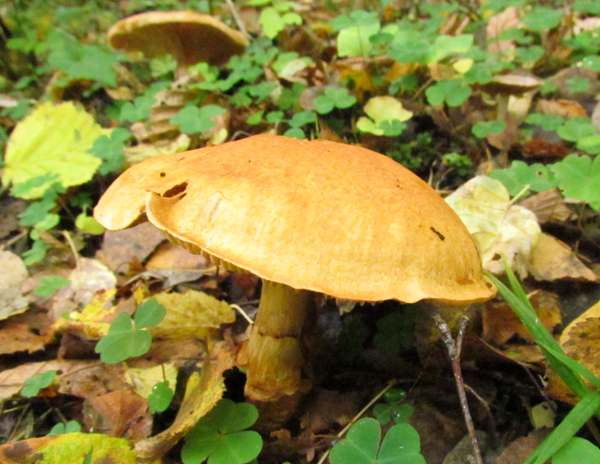
Identification of webcaps is very difficult, and unfortunately there are other yellowish species with macroscopic characteristics similar to this colourful member of the clan; fortunately, the ringed stem is a helpful identifying feature of Cortinarius triumphans.
Distribution
An uncommon but quite widespread species in Britain and Ireland, the Birch Webcap occurs also throughout much of mainland Europe and parts of Asia. Cortinarius triumphans is reported to occur in Iceland and in parts of eastern North America.
Taxonomic history
This striking webcap is a member of the Cortinarius sub-genus Phlegmacium. The Birch Webcap was described in 1838 by Elias Magnus Fries. who gave it the binomial scientific name Cortinarius triumphans which remains its generally-accepted scientific name.
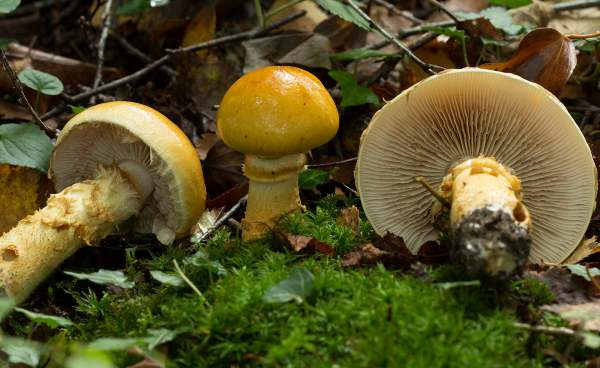
Until recently this webcap was most often recorded as Cortinarius crocolitus Quél., which is now considered to be a synonym of Cortinarius triumphans. (I found the specimen shown here under birches on a roadside in central France.)
Etymology
The generic name Cortinarius is a reference to the partial veil or cortina (meaning a curtain) that covers the gills when caps are immature. In the genus Cortinarius most species produce partial veils in the form of a fine web of radial fibres connecting the stem to the rim of the cap rather than a solid membrane.
Just as you might expect, the specific epithet triumphans means triumphant. Although spotting these large, bright-yellow mushrooms is hardly a triumph of observation, I do feel 'joyful and triumphant' when I stumble across the Birch Webcap.
Toxicity
This mushroom is generally regarded as 'suspect' and may contain dangerous toxins; it should not be gathered for eating. Some Cortinarius species with which darkish specimens of the Birch Webcap could possibly be confused contain the toxin orellanine, which if eaten destroys human kidneys and liver.
Identification guide
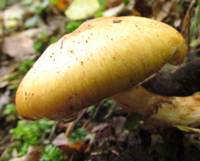 |
Cap
Slimy in wet weather, remaining sticky; 5 to 12cm in diameter; hemispherical to convex at first, expanding until almost flat or occasionally shallowly umbonate but retaining a downturned or slightly incurved margin; golden yellow with a slightly browner centre, the cap surface is radially fibrillose and sometimes becomes slightly scaly towards the centre when fully mature. Cap and stem flesh are pale cream. |
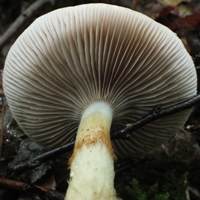 |
Gills
The adnate-emarginate gills are raggedly toothed, close and initially
creamy white with a faint lavender tinge, turning ochre and then becoming stained rusty brown as the spores
mature. A whitish cortina (cobweb-like partial veil) covers the gills of very yound caps. |
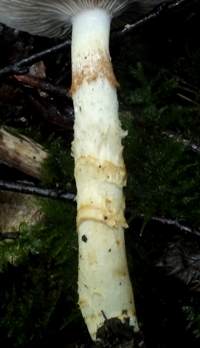 |
Stem
The dry (not slimy) stems are 1.2 to 2.5cm in diameter and 7 to 12cm tall; clavate, sometimes with a basal bulb.
The surface of the stipe is whitish near the apex and pale yellow below, with two or more tan-coloured prominent ring zones. |
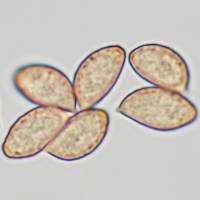 |
Spores
Ellipsoidal to amygdaloid (almond shaped), 10-12.5 x 5.5-7μm; inamyloid.
Spore print
Rusty brown. |
Odour/taste |
Odour not distinctive; taste mild. |
Habitat & Ecological role |
Ectomycorrhizal, in broadleaf and mixed woodlands with birches, Beech and occasionally other broadleaf trees. |
Season |
August to October in Britain and Ireland. |
Similar species |
Cortinarius delibutus hasa yellow cap but its gills are bluish when young.
Cortinarius cinnamomeus has a darker, dry cap. |
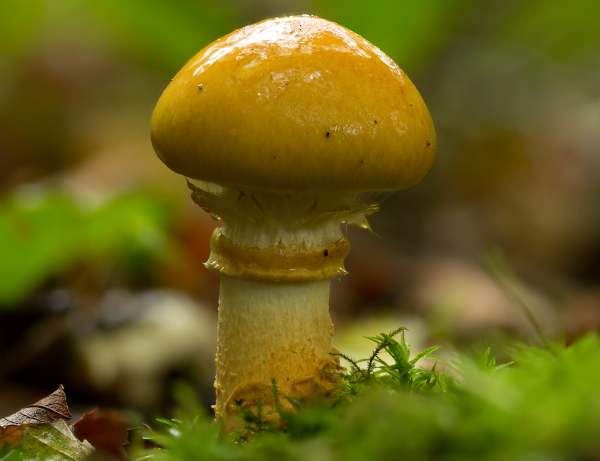
Reference Sources
Fascinated by Fungi, 2nd Edition, Pat O'Reilly 2016, reprinted by Coch-y-bonddu Books in 2022.
Funga Nordica, Henning Knudsen and Jan Vesterholt, 2008.
Fungi of Switzerland Agarics, part 3: Cortinariaceae, Breitenbach, J., Kränzlin, F.
Dictionary of the Fungi; Paul M. Kirk, Paul F. Cannon, David W. Minter and J. A. Stalpers; CABI, 2008
British Mycological Society. English Names for Fungi
Taxonomic history and synonym information on these pages is drawn from many sources but in particular from the British Mycological Society's GB Checklist of Fungi.
Acknowledgements
This page includes pictures kindly contributed by David Kelly.
Top of page...
Fascinated by Fungi. Back by popular demand, Pat O'Reilly's best-selling 450-page hardback book is available now. The latest second edition was republished with a sparkling new cover design in September 2022 by Coch-y-Bonddu Books. Full details and copies are available from the publisher's online bookshop...